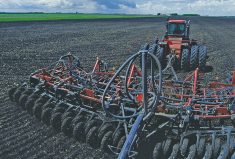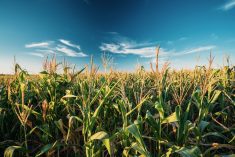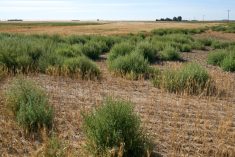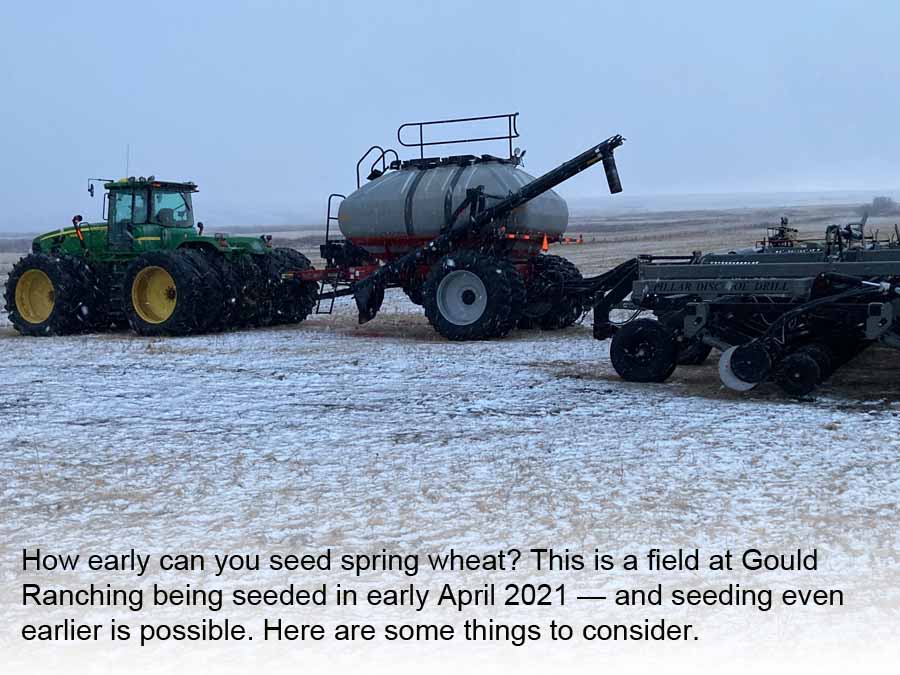While other farmers are still counting down the days until they can start seeding, Matthew and Farley Gould will already be out on their fields, getting it done.
Last year, the brothers started seeding spring wheat nearly a month before their neighbours — and they plan to be “even more aggressive this year.”
“We were slow out of the gate last year but this year, we’re going to give ’er — maybe even run 24 hours a day at seeding if we can,” said Matthew, who farms with his brother and sister Zoë near Consort.
Read Also

Hail research hopes to benefit potato growers
Alberta research scientist measures hail storm and heat dome affects on potato crops
“Going forward, we’re going to pay closer attention to the conditions and the soil temperature and less to the calendar date.”
The Goulds and a few other pioneers are on the bleeding edge in adopting a practice called ultra-early seeding — something that could dramatically alter the traditional work schedules of farmers across the Prairies.
-
PHOTOS: Redefining the growing season
“The earliest we ever seeded in my studies was Feb. 16 down in Lethbridge and March 29 in Edmonton, and the system works quite well,” said Graham Collier, a PhD candidate in agronomy at the University of Alberta who is researching ultra-early seeding.
“There’s a yield benefit, and there’s a growing system stability benefit for this ultra-early planting despite the cold soil and the conditions that you’re going into.”

Virtually no one got a yield bump last year but seeding ultra early may have saved some wheat growers from the worst effects of the drought.
“A lot of the growers who tried it had good establishment because there was good moisture there early, so their crops were further along when that heat really hit us badly at the end of June,” said Collier. “The severity of the drought probably overcame any yield benefits, but with ultra-early seeding, they also likely didn’t see a decrease or yield penalty.”
That was the case at Gould Ranching. Everything started out well, with the crop coming up nicely and withstanding the spring frosts but then “the heat and the drought just took over,” said Farley.
“The drought definitely put a damper on the season, but in the end, it still benefited us seeding early versus seeding later,” he said.
“It was just a really poor year overall, but we didn’t see any downside from seeding earlier,” added Matthew, noting some of their yields were “a little bit better” than their neighbours’.
“Of course it’s tough to tell with the drought, but we definitely didn’t lose any additional yield.”
That’s ultimately the point of an ultra-early seeding system that is based on targeting the optimal soil temperature rather than a traditional seeding date, said Collier. Since 2015, he has been researching ultra-early seeding systems for spring wheat on the Prairies with his supervisors, (Dean Spaner of the University of Alberta and Brian Beres of Agriculture and Agri-Food Canada’s Lethbridge station).

“The trends that are being predicted are reduced consistency of precipitation — more of our precipitation coming earlier in the year — and higher average temperatures throughout the year,” said Collier. “So the whole goal of this system is shifting that planting date earlier to take advantage of that early precipitation and snowmelt, and avoid those hot days until later in the growth cycle.”
In the area where the Goulds farm, the growing season already comes 13 days earlier than it did 70 years ago, according to albertaclimaterecords.com (which has historical weather data from across the province from 1951 to 2017).
Moreover, August tends to be even hotter than July, so “the further along we can get that plant to maturity before that heat hits, the better,” said Matthew.
“The later we go, the more we risk uneven germination in our fields,” he said. “We view this early seeding as reducing our risk of yield fluctuations and combining challenges in the fall.”
The on-farm experience
The Goulds began exploring ultra-early seeding systems last year when they learned a friend from university — Collier himself — had been researching the practice.
“We have a neighbour who is closer to the Saskatchewan border who has been seeding earlier than most people for a number of years, so we combined his anecdotal evidence with Graham’s researched evidence and put the two together,” said Matthew.
The brothers got some strange looks and worried phone calls when they started seeding on April 6 last year. The earliest they had ever seeded was around April 25, with the beginning of May the more usual start date for farmers in their area.
“We had neighbours and family who were genuinely concerned about how early we were seeding, but I think things are different from the ’50s and ’60s where wheat crops were getting frozen and killed in the spring,” said Matthew. “The varieties are different and the weather is different as well. Those past experiences are very relevant, but at the same time, we have to consider the current conditions.”
Part of Collier’s research is to try to measure the financial benefits of ultra-early seeding and so far, the results have been substantial.
“The difference to a grower over the 2015 to 2018 growing seasons down in Lethbridge was $204.64 per hectare, which works out to a gross benefit of $83.66 per acre, simply by moving forward their seeding and increasing their seeding rate.”
It also helps to reduce the stress during the rush-rush planting season, say the Goulds.
“That’s part of the reason we were really aggressive with this on our wheat. It allows us to seed other crops at a more precise timing,” said Matthew. “For our lentils and canola, we’re not going to be able to push that super early, but we can be sitting there ready to seed it at the perfect time.”
Those benefits carry through into harvest.
“We were the first people combining in our area, but we were also the first people seeding by a few weeks,” he noted.
Another “big benefit” was having the crop emerge before the weeds.
“We were actually able to have the wheat out of the ground before weeds even germinated on our fields, so we didn’t do a pre-burn,” said Matthew. “It’s probably year specific — in other years, that might not be possible. But there was no point in doing a pre-burn when there weren’t any weeds growing.”
The Goulds are uncertain how far they can push the envelope, but Matthew said he expects ultra-early seeding to have a permanent place on the operation, depending on the conditions from year to year.
“It’s really field specific and farm specific — what your management strategy is, what your risk is, where your comfort level is,” he said.
Successful ultra-early seeding
But there are a few tricks to making an ultra-early seeding system work.
The first is a seed treatment to help the plant get off to a good start.
“Because the seed is going to sit in the ground longer before it germinates, we do recommend a fungicide seed treatment before it goes into that cool, wet ground,” said Collier.
But choosing the right variety is less important than you might think.
“We evaluated multiple varieties across all of our spring wheat classes and found no differential response among them,” he said, adding federal researchers are now studying ultra-early seeding in durum as well.
“All of those classes of spring wheat performed either the same or better when seeded ultra early.”
There wasn’t a difference in performance among the 13 different varieties they tested either.
“We discovered that we could use our conventional varieties that growers are using right now, and that was an important part of building the system,” said Collier. “All of the varieties performed the same. There was no need to develop cold-tolerant varieties. Everything looked good and yielded well.”
Next, you’ll need to optimize the seeding rate to ensure you have a high enough plant population to survive any weather events that kill off some plants.
“Maintaining a nice, high seeding rate when you’re planting ultra early is really, really important,” said Collier. “We looked at 200 plants per metre squared — so 20 per square foot — versus an optimal rate of 400 plants per metre squared, and the stability was improved by that higher seeding rate. That was one of the real keys to making the system increase in stability over a traditional growing system.
“Having that optimal seeding rate is super important. You can’t underestimate the value of that higher seeding rate.”
So too is the timing of seeding, and the sweet spot for optimum yields is soil temperatures between 2 and 6 C.
“If you delayed beyond six degrees, you ended up with less yield, but if you planted early, right at zero degrees, you didn’t lose any yield going early but the stability wasn’t as good,” he said. “So timing is one of the key contributors to stability and yield increase.”
To do that, you’ll need to understand how and when to take your soil temperature.
“If you’re doing it over multiple days, it should be done at the same time each day so that you get an accurate reading,” he said, adding there’s likely to be variations throughout the field. “You want to take it at about five centimetres of depth so that you aren’t being skewed by a powerful sun on the surface of the dirt that morning.”
You’ll also want to test different areas of your fields, Matthew added.
“Depending on ground cover, your soil temperature could vary greatly. We found that on our farm in different areas,” he said.
But beyond that, ultra-early seeding is “easy to do.”
“You don’t need any special equipment or anything like that. Everything you already have on your farm is part of this system,” said Collier.
And while not every wheat grower in Alberta is likely to want to get in the field as early in the season as they can, ultra-early seeding may be a good place to start thinking about adjusting these production practices as climate change continues to reshape the agricultural landscape of the Prairies, he said.
“This is about responding to our changing environment and taking advantage of being able to move our planting date earlier, while seeing a nice yield and dollar benefit out of it.”
The Alberta Climate Data website contains extensive weather data for every piece of farmland in the province. You can find a primer on how to use the site here.















